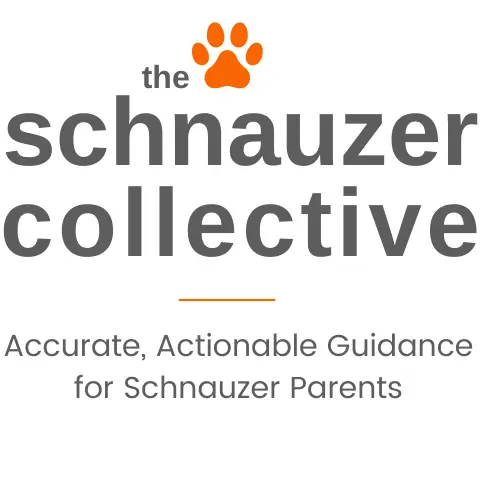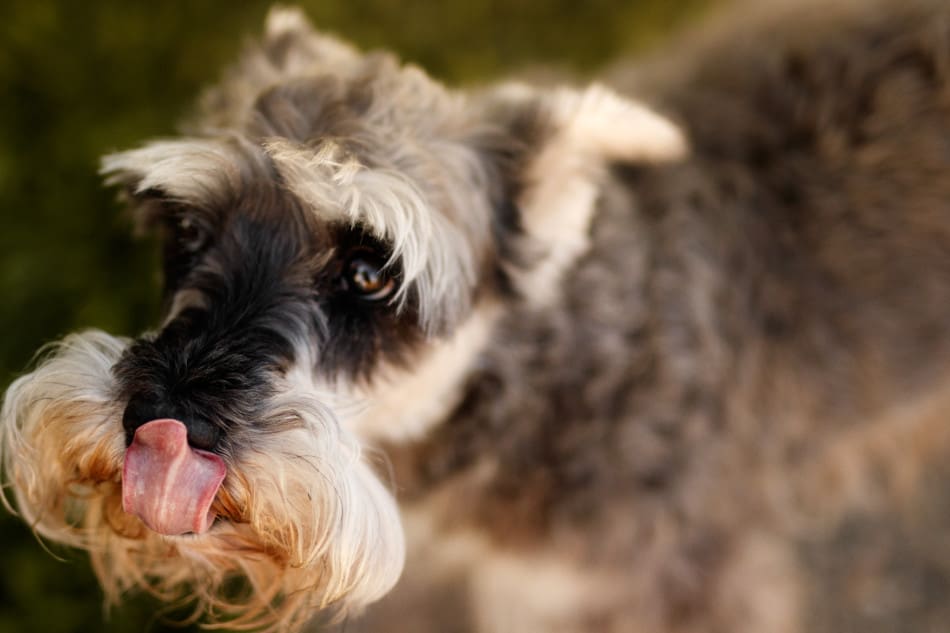Black spots on your Schnauzer can look alarming, no matter where they are located. When they are located on his tongue, gumline, or on the roof of his mouth….especially if they seem to have developed recently…it can seem like the sudden onset of something serious. Our Livi has developed many black spots throughout her entire mouth, tongue, and gumline over the years. It caught me off guard when I first noticed them, so I immediately checked with our veterinarian, did some additional research, and found some answers.
What are the black spots In my Schnauzer’s mouth and should I worry? The black spots in your Schnauzer’s mouth are probably just harmless pigmentation. You should only worry and check with your veterinarian if the spots are raised, change shape rapidly, or become a different texture than your Schnauzer’s tongue or gumline.
While black spots in your Schnauzer’s mouth is most likely harmless, there are a few things you should know and watch for. It’s also a good idea to check his mouth regularly and be on the alert for any changes.
What Is The Most Common Cause of Black Spots in My Schnauzer’s Mouth?
The most common cause for black spots in your Schnauzer’s mouth is melanin. Some dogs have black spots in their mouths from birth and are no cause for concern.
If black spots develop in your Schnauzer’s mouth over time as he ages, it is still most likely harmless. However, you will want to take note of any changes.
A surplus of melanin or pigmentation within skin cells is responsible for human freckles and birthmarks, and this is true for our canine friends as well.
THE SCHNAUZER COLLECTIVE
Melanin is simply a pigmentation substance that is inherited genetically and determines such things as:
- Skin Color
- Hair Color
- Eye Color
Melanin in animals is even responsible for the color of bird feathers, animal fur, and reptile scales…along with their underlying skin color and eye color.
A surplus of melanin or pigmentation within skin cells is responsible for human freckles and birthmarks, and this is true for our canine friends as well.
Black spots on your Schnauzer, whether they are on his body or inside his mouth, are essentially an overabundance of melanin. In short, they are freckles.
In addition, some dogs are more prone to black spots than other. Schnauzers are not on the list of 42 dog breeds who consistently tend to develop black spots in their mouths and tongue, but any dog breed is capable of developing them.
What Do Black Spots Have to Do with Points on a Dog?
Dog who have very dark “points” are more prone to developing black spots in their mouths. Often the spots are dark and very noticeable.
What Are Dog Points?
Points are the locations on a dog that tend to be naturally black, and specifically refer to the color of the:
- Lips
- Nose
- Eye Rims
- Paw Pads
- Toenails
Schnauzer Colors and Points
Due to breeding practices that result in a variety of Schnauzer colors, their points can range from brown, to a liver color, to black.
The only three Schnauzer colors officially recognized for dog showings (competitions) are Black & Silver, Black and Salt & Pepper. However, the AKC will recognize all Schnauzer color combinations for registration.
Colors outside of the three standard options are considered to be “rare” but are becoming very popular as a way to introduce some intriguing visual variety into the breed.

The rare Schnauzer colors include:
- White Miniature Schnauzer
- Chocolate or Liver (Brown) Miniature Schnauzer
- Parti (which is white with patches of another color)
- Black and Silver Miniature Schnauzer
- Chocolate or Liver and Tan Miniature Schnauzer
- Liver and Pepper Miniature Schnauzer
- Silver or Platinum Miniature Schnauzer
- Wheaten Miniature Schnauzer
Depending on the color of your Schnauzer and the lightness or darkness of his corresponding points (again, his lips, nose, eye rims, paw pads, and toenails), he may or may not be prone to developing black spots in his mouth.
Ideally, regardless of your Schnauzer’s color or points, make a regular habit of checking his mouth for changes.
When Should I Worry About Black Spots on My Schnauzer’s Tongue and Gumline?
While most black spots on your Schnauzer’s gumline, mouth roof, and tongue are due to harmless pigmentation, it is possible that they are a sign of something serious.

In general, be on the lookout for any changes that include the following:
- Spots that have appeared suddenly
- Spots that have suddenly changed
- Spots that have a bad odor
- Spots that are not black or blue in color
- Spots that are raised
- Spots that are a different texture from the gumline or tongue
Cancer
Senior Schnauzers can continue to develop dark spots that are harmless. However, particularly in older dogs, spot that appear suddenly on your Schnauzer’s gums, tongue, or mouth can also be a sign of canine melanoma.
In all dog ages, any dark spot that remains flat is probably of no concern. However, if a dark spot is raised at all, you need to consult your veterinarian as soon as possible.
A raised black spot is a sign of melanoma and is the most common oral cancer known to dogs. They can be a very aggressive type of cancer and have a high metastasis incidence.
Some terrier-type breeds are prone to oral cancer such as melanomas, so Schnauzers may be at a higher risk.
In addition, keep in mind that males are more susceptible than females and the melanomas can also be colors other than black, such as white, light gray, or even pink. As a result, ANY raised spot should be immediately examined by your veterinarian.
Periodontal Disease
While black spots, or even long sections of a black gumline, is usually just normal pigmentation, periodontal disease is also a possibility.
If plaque on your Schnauzer’s teeth has been left unattended and has hardened into tartar, the resulting bacteria will cause inflammation.
The inflammation will appear as reddened gums right where the teeth meet the gumline, and is a condition is known as gingivitis. This is the early stage of periodontal disease.
If not treated with a professional teeth cleaning and regular brushing, gingivitis will escalate to a point where you may notice a black line along your Schnauzer’s gumline, right next to his teeth. This stage is a serious health concern and your veterinarian should definitely be involved for a further assessment of any damage.
If the condition worsens, the bacteria will multiply and invade the gums, teeth roots, and even the underlying bone structure of your Schnauzer’s jaw. This advanced stage may ultimately result in tooth loss, bone decay, and even internal organ damage…which can be deadly.
Additional Health Concerns
As I mentioned earlier, any sudden appearance of dark spots should be taken seriously. Involve your veterinarian immediately for an assessment of the underlying cause.
For example, the sudden appearance of dark spots has been known to indicate concerns such as a niacin deficiency, kidney disease, and lung or heart problems.
In all cases where you have questions about the color, texture, or size of dark spots on your Schnauzer’s gumline, tongue or mouth, it’s time to visit the veterinarian.
Related Questions:
How Often Should I Brush My Schnauzer’s Teeth and Check His Mouth? If you are in the top 2% of dog owners, you will brush your Schnauzer’s teeth every single day. This not only ensures top-notch oral hygiene, but also gives you an opportunity to check his mouth for any unusual developments. In reality, however, brushing and inspecting his teeth and mouth several times per week should be regular enough. A consistent schedule will maintain good dental hygiene and keep you aware of any abnormal changes.
Can a Schnauzer’s Gumline Turn Different Colors? Generally speaking, a Schnauzer’s gumline should be a nice, healthy “bubblegum” pink. However, black spots are common and usually harmless. You can determine a lot of basic information from the color of his gums and being armed with fundamental information will help you stay alert to any changes and potential problems. While details are sometimes more complex, here are some basics: If his gums are purple or gray and they don’t refill with blood quickly when you press on them (called “capillary return”), he may be in shock. If they are bright red, he may have been exposed to a toxin or is fighting an infection. If the gums are white, he has lost blood, and the bleeding may be external or internal.
And finally, from one pet parent to another, discover my all-time favorite resources designed to cover your every Schnauzer need. I’ve done the legwork for you so you can spend more time with the people and fur friends in your life.
A portion of all profit earned on this site is donated to Pet Partners
whose mission is to improve human health and
well-being through the human-animal bond.
They train and register pets to become therapy animals,
and have local chapters in many states.

